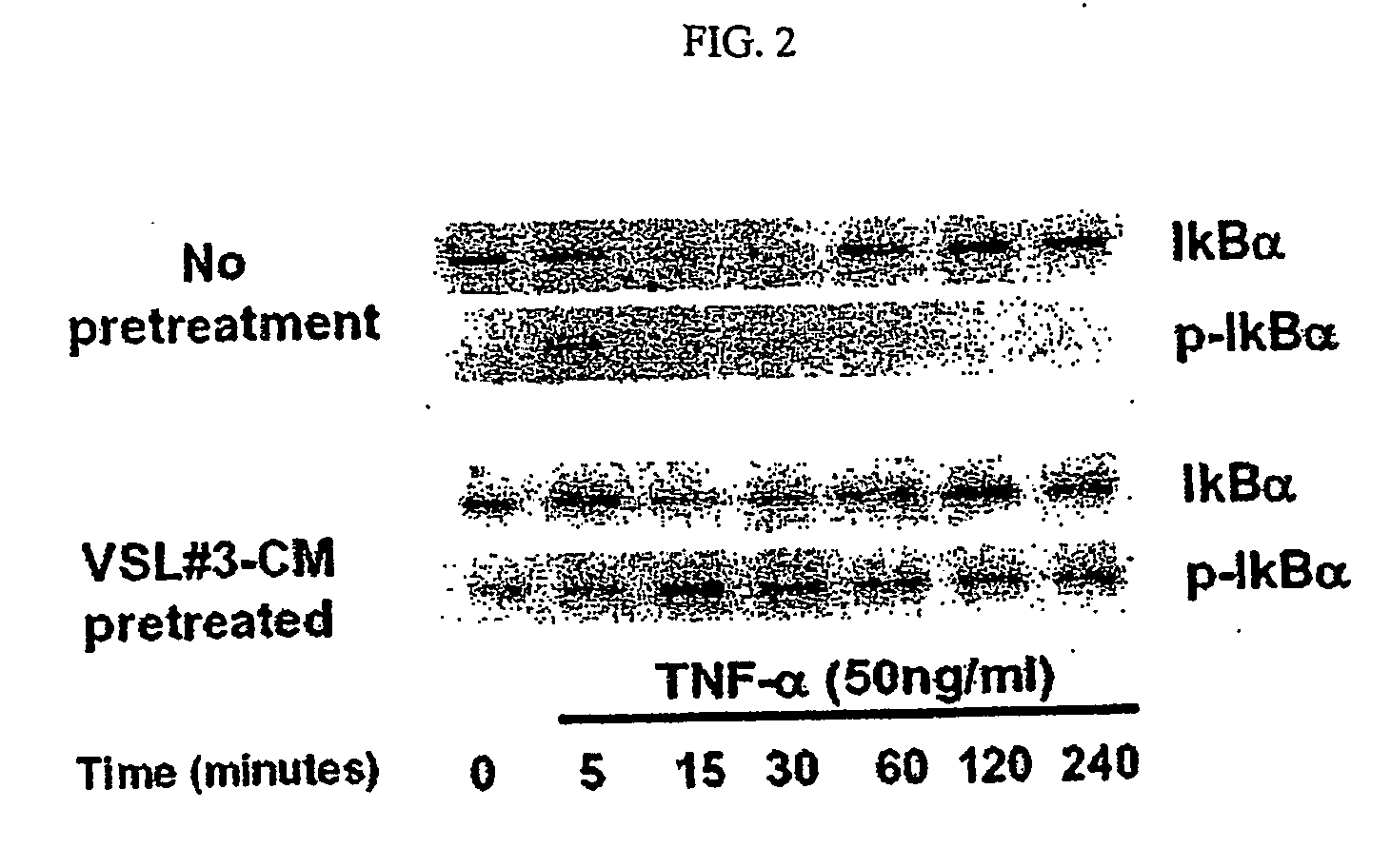Anti-inflammatory, cytoprotective factor derivable from a probiotic organism
a probiotic organism and anti-inflammatory technology, applied in the field of inflammation disorders, can solve the problems of ulcerative colitis, ibd development in susceptible individuals, theories about, etc., and achieve the effect of increasing expression and inhibiting the activity of chymotrypsin-like proteasomes
- Summary
- Abstract
- Description
- Claims
- Application Information
AI Technical Summary
Benefits of technology
Problems solved by technology
Method used
Image
Examples
example 1
General Methodologies
Probiotic Bacterial Culture and Generation of Conditioned Media
[0142] The probiotic formulation, VSL#3 (VSL Pharmaceuticals, Gaithersburg, Md.), contains Streptococcus salivarius subsp. thermophilus, Lactobacillus casei, Lactobacillus plantarum, Lactobacillus acidophilus, Lactobacillus delbrueckii subsp. bulgaricus, Bifidobacteria longum, Bifidobacteria infantis, and Bifidobacteria breve at a concentration of 5×1011 lyophilized bacteria / gram. VSL#3 (batch number 2034-A2, VSL Pharmaceuticals, Gaithersburg, Md.) was grown to a concentration of approximately 2×1014 (as determined by colony counts) in phenol red-free RPMI 1640 medium for 16 hours, then centrifuged at low speed in a tabletop Sorvall centrifuge (3000×g, 4° C., 10 minutes). The supernatant (conditioned medium) was then passed through a 0.22 micron low protein-binding filter (Millipore, Bedford, Mass.) to remove all bacterial cells and debris. Aliquots of conditioned medium were stored in sterile mic...
example 2
Probiotics Inhibit NF-κB Activation in Intestinal Epithelial Cells
[0153] To determine whether the bacteria in VSL#3 secrete factors possessing anti-inflammatory activity, the effects of VSL#3-conditioned media (VSL#3-CM) on the NF-κB pathway were investigated. The ability of VSL#3-CM to block transcriptional activity of NF-κB in intact epithelial cells stimulated by TNF-α was tested using an NF-κB luciferase reporter assay.
[0154] NF-κB luciferase assays were performed using the Promega Dual Luciferase Reporter 1000 Assay System (Promega, Madison, Wis.) and plasmids were transfected using TransIT LT-1 transfection reagent (Mirus, Madison Wis.) as per the manufacturer's instructions. Briefly, 2 μg of NF-κB response element-driven firefly luciferase reporter plasmid (Clontech, Palo Alto, Calif.) and 0.2 μg Thymidine Kinase (TK) promoter-driven Renilla reporter plasmid (Promega, Madison Wis.) were mixed with LT-1 polyamine transfection reagent. After formation of complexes, the soluti...
example 3
Probiotic-conditioned Medium Inhibits MCP-1 Release
[0156] Probiotics decrease release of Monocyte Chemoattractant Protein 1 (MCP-1) in response to NF-κB stimulation by TNF-α. MCP-1 is an endogenous immune response gene that has been implicated in the pathogenesis of many inflammatory diseases such as multiple sclerosis, rheumatoid arthritis, and IBD. Like IL-8, studies have shown that MCP-1 is highly expressed in areas of active inflammation in Crohn's disease and its expression depends on NF-κB activation.
[0157] YAMC cells were grown and treated with VSL#3-CM and subsequently treated with TNF-α, as described herein, to stimulate NF-κB activation. Supernatants were harvested and tested for the production of MCP-1 using a mouse MCP-1 ELISA kit (Pierce Endogen, Rockford, Ill.) as per the manufacturer's instructions to measure MCP-1 release from the cells. Treatment of intestinal epithelial cells with VSL#3-CM attenuated the release of MCP-1 in response to NF-κB stimulation by TNF-α ...
PUM
| Property | Measurement | Unit |
|---|---|---|
| Fraction | aaaaa | aaaaa |
| Heat | aaaaa | aaaaa |
Abstract
Description
Claims
Application Information
 Login to View More
Login to View More - R&D
- Intellectual Property
- Life Sciences
- Materials
- Tech Scout
- Unparalleled Data Quality
- Higher Quality Content
- 60% Fewer Hallucinations
Browse by: Latest US Patents, China's latest patents, Technical Efficacy Thesaurus, Application Domain, Technology Topic, Popular Technical Reports.
© 2025 PatSnap. All rights reserved.Legal|Privacy policy|Modern Slavery Act Transparency Statement|Sitemap|About US| Contact US: help@patsnap.com



